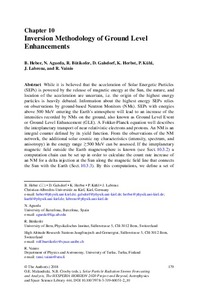Inversion Methodology of Ground Level Enhancements
B. Heber; D. Galsdorf; J. Labrenz; K. Herbst; N. Agueda; P. Kühl; R. Bütikofer; R. Vainio
https://urn.fi/URN:NBN:fi-fe2021042720268
Tiivistelmä
While it is believed that the acceleration of Solar Energetic Particles (SEPs) is powered by the release of magnetic energy at the Sun, the nature, and location of the acceleration are uncertain, i.e. the origin of the highest energy particles is heavily debated. Information about the highest energy SEPs relies on observations by ground-based Neutron Monitors (NMs). SEPs with energies above 500 MeV entering the Earth’s atmosphere will lead to an increase of the intensities recorded by NMs on the ground, also known as Ground Level Event or Ground Level Enhancement (GLE). A Fokker-Planck equation well describes the interplanetary transport of near relativistic electrons and protons. An NM is an integral counter defined by its yield function. From the observations of the NM network, the additional solar cosmic ray characteristics (intensity, spectrum, and anisotropy) in the energy range ≳ ≳
500 MeV can be assessed. If the interplanetary magnetic field outside the Earth magnetosphere is known (see Sect. 10.3.2) a computation chain can be set up in order to calculate the count rate increase of an NM for a delta injection at the Sun along the magnetic field line that connects the Sun with the Earth (Sect. 10.3.3). By this computations, we define a set of Green’s functions that can be fitted to an observed GLE to determine the injection time profile. If the latter is compared to remote sensing measurements like radio observations conclusions of the most probable acceleration process can be drawn.
Kokoelmat
- Rinnakkaistallenteet [19207]
